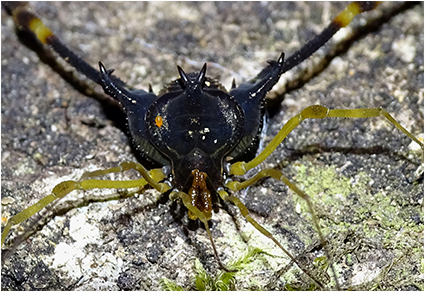Abstract
Two new species of the Chilean endemic genus Neogonyleptes Roewer, 1913 are described based on specimens obtained in the Nahuelbuta mountain range, Biobío and La Araucanía Regions. The new taxa are morphologically allied to Neogonyleptes karschii (Sørensen, 1902); however, both differ from all species of the genus by their dorsal scutum area III+IV, which is armed with a large, apically bifurcate apophysis. Neogonyleptes floresi sp. nov. differs from N. pedrazai sp. nov. principally in the slender body and legs, the proximal constriction of the scutal apophysis, and the distally straight prolateral apophysis on coxa IV. Detailed descriptions, illustrations, and comparisons of the new species are given. Additionally, some comments are provided about the taxonomy of Neogonyleptes and allied genera.
References
Acosta, L.E., Pérez-González, A. & Tourinho, A.L. (2007) Methods for taxonomic study. In: Pinto-Da-Rocha, R., G. Machado & Giribet, G. (Eds.), Harvestmen: The Biology of Opiliones. Harvard University Press, Cambridge, Massachussetts, pp. 494–505.
Acosta, L.E. (2020) Qorimayus, a new genus of relictual, high-altitude harvestmen from western Argentina (Arachnida, Opiliones, Gonyleptidae) reveals trans-Andean phylogenetic links. Zootaxa, 4722 (2), 129–156. https://doi.org/10.11646/zootaxa.4722.2.2
Butler, A.G. (1874) Descriptions of five new species of Gonyleptes. Journal of the Linnean Society of London, 12, 151–155. https://doi.org/10.1111/j.1096-3642.1875.tb02579.x
Canals, J. (1936) Los Opiliones de Chile. Revista Chilena de Historia Natural, 39, 68–71.
Cekalovic, T. (1968) Conocimiento actual de los opiliones chilenos. Noticiario Mensual del Museo Nacional de Historia Natural, Santiago, l2 (138), 5–11.
Cekalovic, T. (1985) Catálogo de los Opiliones de Chile (Arachnida). Boletín de la Sociedad de Biología de Concepción, 56, 7–29.
Ferreira, D.P. & Kury, A.B. (2010) A review of Roquettea, with description of three new Brazilian species and notes on Gryne (Opiliones, Cosmetidae, Discosomaticinae). Zoological Science, 27, 697–708. https://doi.org/10.2108/zsj.27.697
Genovart, M. (2009) Natural hybridization and conservation. Biodiversity and Conservation, 18, 1435–1439. https://doi.org/10.1007/s10531-008-9550-x
Giribet, G., Edgecombe, G.D., Wheeler, W.C. & Babbitt, C. (2002) Phylogeny and systematic position of Opiliones: A combined analysis of Chelicerate relationships using morphological and molecular data. Cladistics, 18, 5–70. https://doi.org/10.1006/clad.2001.0185
Irwin, D. & Schluter, D. (2021) Hybridization and the coexistence of species. bioRxiv 17 pp. [2021 August preprint] https://doi.org/10.1101/2021.04.04.438369
Kirby, W. (1818) A century of insects, including several new genera described from his Cabinet. Transactions of the Linnean Society of London, 12 (27), 375–453. https://doi.org/10.1111/j.1095-8339.1817.tb00239.x
Kury, A.B. (2003) Annotated catalogue of the Laniatores of the New World (Arachnida, Opiliones). Revista Ibérica de Aracnología, Volumen Especial Monográfico, 1, 5–337.
Kury, A.B. & Medrano, M. (2016) Review of terminology for the outline of dorsal scutum in Laniatores (Arachnida, Opiliones). Zootaxa, 4097 (1), 130–134. https://doi.org/10.11646/zootaxa.4097.1.9
Kury, A.B. & Villarreal, O. (2015) The prickly blade mapped: establishing homologies and chaetotaxy for macrosetae of penis ventral plate in Gonyleptoidea (Arachnida, Opiliones, Laniatores). Zoological Journal of the Linnean Society, 174, 1–46. https://doi.org/10.1111/zoj.12225
Loman, J.C.C. (1899) Die Opilioniden der Sammlung Plate. Zoologische Jahrbücher Supplement, Fauna Chilensis, 4 (2), 1–14.
Maury, E.A. (1992) Gonyleptidae (Opiliones) del bosque subantartico chileno-argentino II. Los géneros Corralia Roewer, 1913 y Spinivunus Roewer, 1943. Boletín de la Sociedad de Biología de Concepción, Chile, 63, 133–145.
Mello-Leitão, C.F.de. (1926) Notas sobre Opiliones Laniatores sul-americanos. Revista do Museu Paulista, 14, 327–383.
Mello-Leitão, C.F.de. (1932) Opiliões do Brasil. Revista do Museu Paulista, 17 (2), 1–505.
Mello-Leitão, C.F.de. (1935) Algumas notas sobre os Laniatores. Arquivos do Museu Nacional, Rio de Janeiro, 36 (4), 87–116.
Mello-Leitão, C.F.de. (1944) Alguns curiosos e interesantes opiliões brasileiros. Annais da Academia Brasileira de Ciencias, 16 (1), 13–22.
Pérez-Schultheiss, J., Urra, F. & Otárola, A. (2019) Opiliones Laniatores (Arachnida) de la Cordillera de Nahuelbuta: un desconocido hotspot de diversidad. Boletín Nahuelbuta Natural, 4, 1–24.
Pérez-Schultheiss, J., Urra, F. & Oyarzún, C. (2021) Opiliones Laniatores (Arachnida) de Manquemapu, Cordillera de la costa de Purranque, Región de Los Lagos, Chile. Revista Chilena de Entomología, 47 (2), 405–432. https://doi.org/10.35249/rche.47.2.21.25
Pinto-da-Rocha, R. (2002) Systematic review and cladistic analysis of the Caelopyginae (Opiliones: Gonyleptidae). Arquivos de Zoologia, São Paulo, 36 (4), 357–464.
Pinto-Da-Rocha, R., Bragagnolo, C., Marques, F.P.L. & Antunes Junior, M. (2014) Phylogeny of harvestmen family Gonyleptidae inferred from a multilocus approach (Arachnida: Opiliones). Cladistics, 30 (5), 519–539. https://doi.org/10.1111/cla.12065
Piza, Jr.S.T.de. (1940) Breves considerações em torno de alguns Gonyléptidas do Brasil. Revista de Agricultura Piracicaba, 15 (7–8), 312–324.
Roewer, C.F. (1913) Die Familie der Gonyleptiden der Opiliones-Laniatores. Archiv für Naturgeschichte, 79A (4), 1–256 and 79A (5), 257–473.
Roewer, C.F. (1923) Die Weberknechte der Erde. Sistematische Bearbeitung der bisher bekannten Opiliones. Gustav Fischer, Jena, 1116 pp.
Roewer, C.F. (1930) Weitere Weberknechte IV. (4. Ergänzung der Weberknechte der Erde, 1923). Abhandlungen herausgegeben vom Naturwissenschaftlichen Verein zu Bremen, 27 (3), 341–452.
Soares, H.E.M. (1968) Contribuição ao estudo dos opiliões do Chile (Opiliones: Gonyleptidae, Triaenonychidae). Papéis Avulsos de Zoologia, 21, 259–272.
Soares, B.A.M. & Soares, H.E.M. (1949) Monografia dos gêneros de opiliões neotrópicos II. Arquivos de Zoologia do Estado de São Paulo, 7 (2), 149–240.
Sørensen, W. (1884) Opiliones Laniatores (Gonyleptides W. S. olim) Musei Hauniensis. Naturhistorisk Tidsskrift, Kjøbenhavn, 14 (3), 555–646.
Sørensen, W. (1902) Gonyleptiden (Opiliones Laniatores). Hamburger Magalhaensische Sammelreise, 5, 1–36.
Sundevall, C.J. (1833) Conspectus Arachnidum. London, C.F. Berling, 39 pp.
Thorell, T.T.T. (1876) Sopra alcuni Opilioni (Phalangidea) d’Europa e dell’Asia occidentale, con un quadro dei generi europei di quest’Ordine. Annali del Museo Civico di Storia Naturale (Genoa) series 1, 8, 452–50. https://doi.org/10.5962/bhl.part.10418


